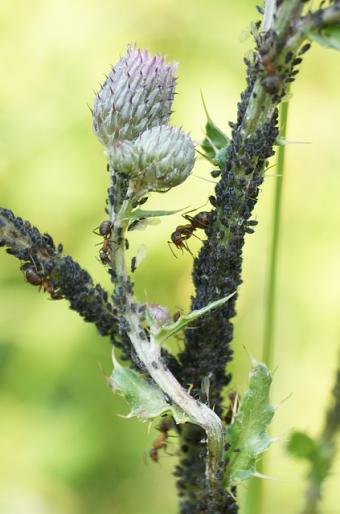
Aphids are perhaps the most common of all garden pests. Fortunately, they are among the easiest pests to deal with and rarely cause serious ongoing damage to the garden.
Aphid Overview
Tiny and almost motionless, aphids can easily go undetected, but are often the cause of stunted growth in plants. Aphids are not as prevalent in tropical areas like southern Florida, but are prevalent in all other parts of the country.
Appearance
Aphids are typically about one to two millimeters in size - larger than a pinhead, but smaller than a pea - and are usually found on tender young stems of plants, typically clustered around the growing tips. They also congregate on the undersides of leaves.
- Aphids may be green, yellow, whitish, brown, black, pink or reddish in color.
- They cluster in dense groups which appear motionless, but they do move about very slowly over the course of their lifespan.
- The whitish shells of aphids that have molted are always found together with groups of live aphids.
There will also be aphids of various sizes within each group which represent different ages and stages of growth. Eventually, adult aphids undergo a final stage of metamorphosis where they develop wings and fly off to another plant to lay their eggs, starting the life cycle again.
 |
 |
Effect on Plants
Aphids suck the sap out of the stems of plants preventing them from growing. The stems will slowly begin to desiccate and appear shriveled. If the infestation is severe, individual plants may die.
Aphids are most problematic on small herbaceous plants. They attack the growing tips of shrubs and trees as well, but rarely cause serious damage to these woody species.
Ants and Aphids

If you see ants crawling up and down the stems of your plants, there is a good chance they are visiting a group of aphids. Ants themselves do no harm to plants, but they feed on a sugary substance secreted by the aphids, called honeydew.
The ecological relationship between ants and aphids has co-evolved for so long that ants have actually developed aphid protecting behaviors - they actively work to defend the tiny aphids against the larger predatory insects that feed on them.
Detect With Honeydew Signs
The sweet substance that ants feed on is very sticky and can build up on the stems of plants and foster fungal diseases. Thus in the case of severe aphid infestations, a sticky greyish substance is often visible where mold spores have colonized the honeydew, further degrading the health of the plant.
Furthermore, where aphids have infested the growing tips of trees the mold infested honeydew tends to drip to the ground, making a mess of patios, driveways and other paved surfaces, as well as cars and other objects.
Aphid Control

A certain level of aphid population can usually be tolerated in the garden, but if they get out of hand there are several approaches to combatting them.
However, dealing with aphids on large trees is usually impractical for homeowners. Arborists have special tools that allow them to spray aphids high up in the canopy, which is sometimes a worthwhile expenditure - especially if the honeydew is making a mess below - but is rarely warranted for the sake of the tree's health, which can usually tolerate the infestation without lasting harm.
Natural Methods
There are a few easy, all natural ways to deal with an aphid infestation:
- Clip off the infested portions of each plant and hope that the aphids do not return when the plant grows back -- just be sure to dispose of the infected plant material in the trash so the aphids can't fly back to the garden.
- If there are just a few infected plants, a sharp blast of water can be employed to dislodge them -- this is especially effective for indoor plants where the aphids can be washed down the drain.
- There are also various all-natural aphid insecticides, the most common of which involves nothing more than water, dish soap and vegetable oil and can be made at home.
- Natural predators of aphids may also be released in the garden such as ladybugs and green lacewings, available at garden centers or from mail order suppliers.
Chemical Control
Any chemical insecticide labeled for soft-bodied insects, such as malathion sprays or Sevin dust, are possible remedies for controlling aphids.
The upside of these products is that they will continue to repel aphids for a short period after they are applied while the natural sprays typically do not.
The downside is that the chemical sprays will also kill beneficial insects - they very ones that prey on aphids - making gardeners reliant on these chemical controls as the natural system of checks and balance is destroyed.
Part of an Ecosystem
Aphids are an integral part of every ecosystem, including gardens. When the ecosystem is in balance, their populations should remain low (thanks to their natural predators), allowing the plants to tolerate mild attacks. But if there is a population boom, you may choose to combat it to save a valued planting.







